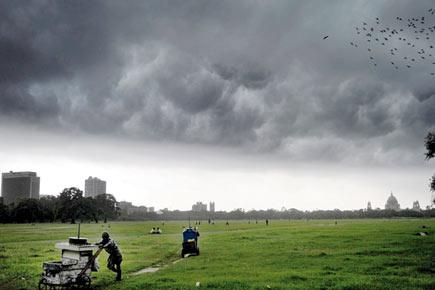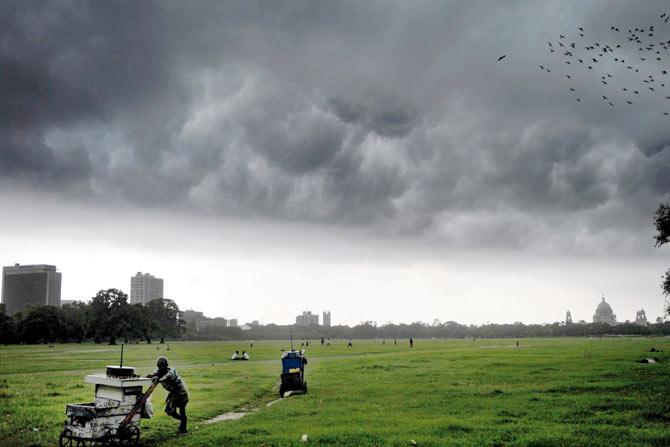Do join us for the annual monsoon lunch which we are hosting this year. There will be khichudi, beguni and ileesh maachh bhaja,” Mrs Banerjee was insistent with her invitation, as I got out of the car, a Saab fitted with a fabulous music system from whose unseen speakers Hemanta Mukherjee's digitised voice wafted out, warm and mellifluous, untouched by the icicle-forming chill of the air conditioner on full blast. Even at this late hour, almost close to midnight, the heat outside was blistering.

 Do join us for the annual monsoon lunch which we are hosting this year. There will be khichudi, beguni and ileesh maachh bhaja,” Mrs Banerjee was insistent with her invitation, as I got out of the car, a Saab fitted with a fabulous music system from whose unseen speakers Hemanta Mukherjee's digitised voice wafted out, warm and mellifluous, untouched by the icicle-forming chill of the air conditioner on full blast. Even at this late hour, almost close to midnight, the heat outside was blistering.
Do join us for the annual monsoon lunch which we are hosting this year. There will be khichudi, beguni and ileesh maachh bhaja,” Mrs Banerjee was insistent with her invitation, as I got out of the car, a Saab fitted with a fabulous music system from whose unseen speakers Hemanta Mukherjee's digitised voice wafted out, warm and mellifluous, untouched by the icicle-forming chill of the air conditioner on full blast. Even at this late hour, almost close to midnight, the heat outside was blistering.
Summer in this part of the US can be as bad as what we have to suffer in the dust bowl of India, also known as the National Capital Region. It had been a hot and humid day and I had sweated profusely, walking from one building to another in the sprawling university campus. I had looked forward to an easy, boozy evening of casual banter at the house of a professor of Cinema, a laid back child of the sixties — now approaching middle-age — with vivid memories of Woodstock, who was hosting a reception for me to meet Indian American members of the faculty. Nearly all of them turned out to be Bengalis, barring a professor of Mathematics, whose father had fled to the US when Brahmins were banished from Tamil Nadu.
ADVERTISEMENT

Monsoon clouds loom overhead in Kolkata in August. The annual monsoon lunch in the US, a place where it does not rain and from where their children cannot even begin to imagine the incessant downpour that drenches Kolkata every year, helps them retain their 'Bong' connection. Pic for Representation/AFP
The evening was boozy and the grill was wonderful, though I thought the 'hot' sauce was a bit of a scam, but there was little casual banter. The faculty members were serious and ponderous, more so the ex-Jadavpur University lot, which was given to both hectoring and lecturing me, their poor upcountry cousin who was visiting America courtesy a State Department grant.
Among them was Prof Banerjee, who taught some exotic course related to Particle Physics. From Garfa Main Road to this university town, he had travelled a long distance, moving up from the crowded footboards of the ramshackle double-decker buses plying on the 8B route to a cool, silver-blue Saab.
Mrs Banerjee — who too had travelled a long distance from Bagha Jatin and no longer needed the comfort of the 'Ladies Seat' on the 8B bus, the only seat with its dark green rexine intact — on hearing that I had been away from home, and Bengali food, for more than a month, promptly invited me to her annual monsoon lunch on Saturday, which was two days later. I graciously accepted her invitation.
When I reached their home, I wasn't quite prepared for something so theatrical. The curtains of their cavernous drawing room and sprawling dining space had been tightly drawn to recreate the dark and gloomy days of monsoon in West Bengal. The place was teeming with expatriate Bengalis, the men dressed in kurta-pajama (or pajama-panjabi, as Bengalis prefer to describe this attire) — some of them were wearing neatly pleated dhuti — and the women were clad in heavy brocade and Banarasi saris.
There were two incongruities: The ubiquitous can of Budweiser beer (everybody seemed to be holding one) — the abiding symbol of American 'taste', and me, dressed in T-shirt and khakis (everybody stared at me as if I were an intruder at a secret society's ritual ceremony, an alien amid the natives). The bouquet of expensive perfumes and after-shave lotions mixed with the smell of khichudi (bubbling in a pot), begun bhaja (sputtering in a pan) and ileesh maachh (sizzling in another pan) in the open kitchen off the dining space to swamp the absence of the more-alluring — some would say seductive — aroma of Joba Kushum hair oil, Kanta scent and Cuticura talcum powder, associated with such gatherings back home.
As high noon turned into afternoon and the women exchanged gossip or sang along, often gratingly out of tune and scale, with Rabindra sangeet playing in the background, while the men got sozzled on Budweiser — of which there seemed to be an unending supply — Mrs Banerjee announced lunch was ready. It was a hearty feast washed down with more Budweiser.
I gingerly poked at the extra-large piece of ileesh maachh, which Mrs Banerjee had selected for me from the platterful of fried fish. It tasted like ileesh but wasn't quite the same. And how did she manage to find ileesh at the local supermarket? “That's shad you are eating,” Prof Banerjee's colleague in the department helpfully informed me, “In America, we use this as a substitute for ileesh.”
Later that evening, back in my room at the hotel, I marvelled at the enduring — and, despite its comic elements — and endearing effort by a group of Bengalis, far away from their land of birth and origin, to cling on to an idiom, which for them was central to their cultural identity. The annual monsoon lunch in a place where it does not rain and from where their children cannot even begin to imagine the incessant downpour that drenches Kolkata every year helps them retain their 'Bong' connection.
The sense of alienation that immigrants feel in a foreign land, which Manju Kapur has sought to capture in her latest novel, The Immigrant, through the tragic yet elevating story of Nina and Ananda, the constant conflict between your own culture and that of your adopted country, remarkably crafted into everyday stories about first- and second-generation immigrants by Jhumpa Lahiri in Unaccustomed Earth, the wistful longing that underlines desire and its suppression of which Bharati Mukherjee has written with great effect, are something which we, who have refused to move and migrate, can never really either appreciate or understand.
The writer is a senior journalist based in the National Capital Region. His Twitter handle is @KanchanGupta
 Subscribe today by clicking the link and stay updated with the latest news!" Click here!
Subscribe today by clicking the link and stay updated with the latest news!" Click here!







